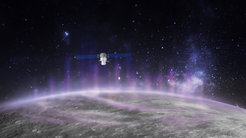Electron Rain Triggers Mercury's Auroras
During its first flyby of Mercury, the spacecraft BepiColombo captured unique measurement data. They help to understand the planet's X-ray auroras.
Unlike the auroras seen on Earth, those witnessed on Mercury are not visible to the naked eye, but emit only X-rays. In today's issue of the journal Nature Communications, a group of researchers including scientists from the Max Planck Institute for Solar System Research in Germany describe how electrons from the solar wind pelt the planet, triggering the high-energy glow. The team evaluated data recorded by the European-Japanese spacecraft BepiColombo during its flyby of Mercury in early October 2021. The analyses show for the first time in detail how the auroras of the planet closest to the Sun are formed. In addition, the data suggest that despite a wide variety of conditions in the Solar System, auroras are always due to the same process.

Apart from Earth, also other planets in the Solar System adorn themselves with a striking glow over their polar regions. The enormous auroras of Jupiter, for example, extend over an area with a diameter of more than 40,000 kilometers. The fact that extremely energetic X-ray polar lights can occur at Mercury's north and south poles had already been observed by the American space probes Mariner 10 in the 1970s and MESSENGER between 2011 and 2015. As on Earth, charged particles from the solar wind trapped in the planet's magnetic field trigger the phenomenon. However, while on Earth the solar wind particles hit the atmosphere and ionize molecules there, Mercury offers different conditions. The planet is surrounded only by a so-called exosphere, an extremely thin layer of gas. The solar wind particles therefore strike the planet's surface directly.
Flyby with a good view
"Exactly how Mercury's auroras are created was previously unclear," said MPS scientist Dr. Markus Fränz, co-author of the current study and a member of BepiColombo’s Mercury Plasma Particle Experiment (MPPE) team. The trajectories of Mariner 10 and MESSENGER only allowed for a view of the planet's northern hemisphere. In addition, neither mission was able to study electrons in Mercury's vicinity. Thus, a complete picture of the formation process could not be obtained. The new measurement data from BepiColombo now create a completely new situation.
BepiColombo was launched into space in October 2018 and will enter orbit around Mercury in 2025. Until its arrival, a total of six Mercury flybys are scheduled in the mission’s calendar; the first of which occurred in October 2021. From a distance of about 200 kilometers, MPPE had the opportunity to precisely determine the distribution and energies of the particles in Mercury's environment. The instrument consists of several sensors, each specialized for particles of a particular type and velocity. The MPS contributed to the development and construction of MPPE’s mass spectrometer.
A "rain" of electrons

During the flyby 21 months ago, MPPE was for the first time able to obtain measurement data from the northern night side, as well as over the day side of the southern hemisphere, determining the structure of the magnetosphere, the region of influence of the planetary magnetic field, and its boundary, the magnetopause. As with Earth, Mercury's magnetosphere is distorted into a long tail on the side away from the Sun; on the side facing the Sun, it showed itself to be highly compressed. "The solar wind must have been particularly strong at the time of the measurements," concludes MPS scientist Dr. Norbert Krupp, also a co-author of the study and a member of the MPPE team.
In addition, MPPE was able to precisely trace the formation process of Mercury's polar lights. Coming from the magnetosphere’s tail, high-energy electrons travel along the magnetic field lines toward the planet. There they "rain" down on it, interacting with the surface material at its poles. This ionizes molecules, which in turn emit high-energy X-rays as a result.
Lead author, Sae Aizawa, of the Institut de Recherche en Astrophysique et Planétologie (IRAP), now at JAXA's Institute of Space and Astronautical Science (ISAS) and University of Pisa, Italy, said: “For the first time, we have witnessed how electrons are accelerated in Mercury’s magnetosphere and precipitated onto the planet's surface. While Mercury’s magnetosphere is much smaller than Earth’s and has a different structure and dynamics, we have confirmation that the mechanism that generates aurorae is the same throughout the Solar System.”
In the next few years, BepiColombo will fly close to Mercury three more times. The next encounter is planned for September of next year.













